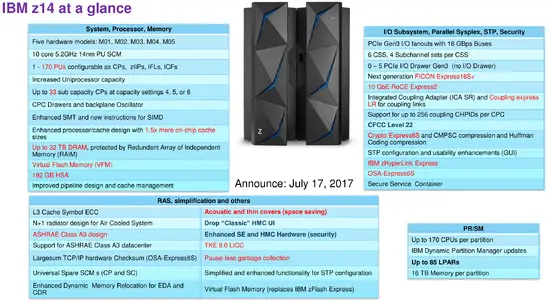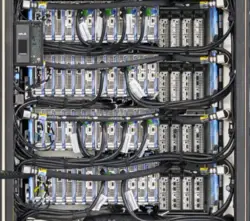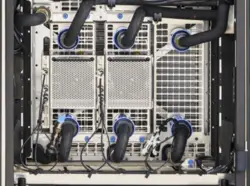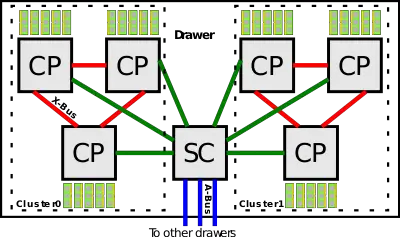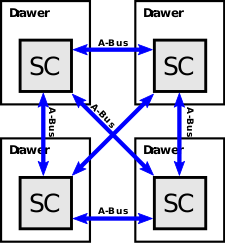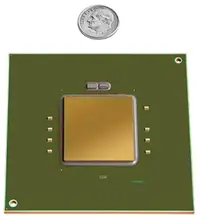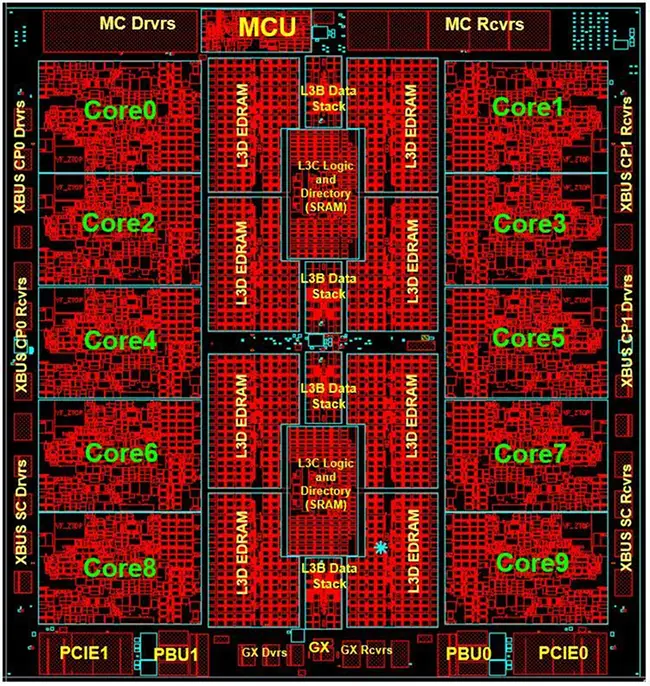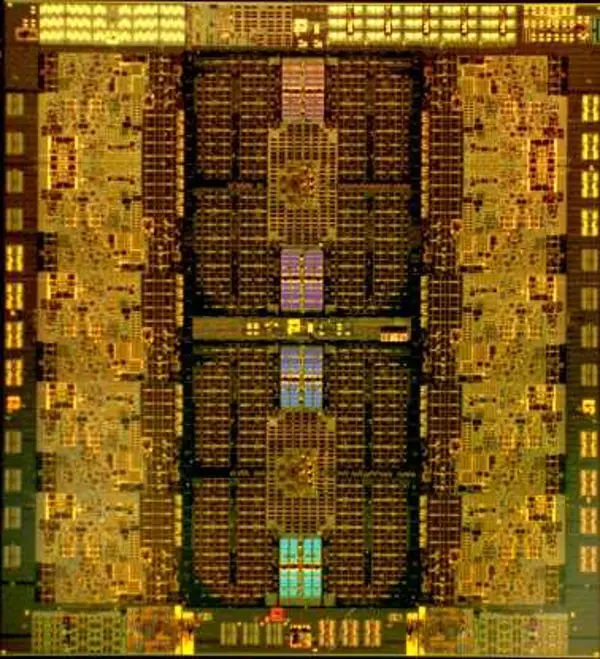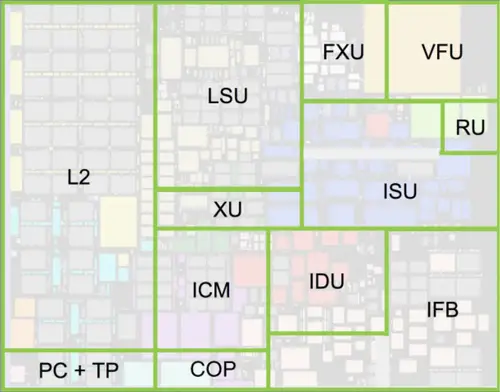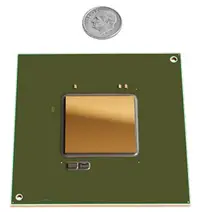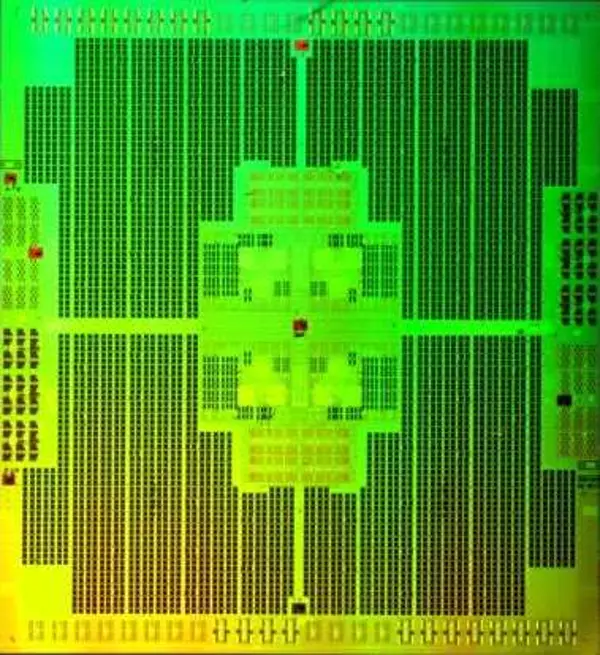(→Process Technology) |
(→Mainframe: Fixed grammar) |
||
| (35 intermediate revisions by 3 users not shown) | |||
| Line 7: | Line 7: | ||
|introduction=July 17, 2017 | |introduction=July 17, 2017 | ||
|process=14 nm | |process=14 nm | ||
| + | |cores=7 | ||
| + | |cores 2=8 | ||
| + | |cores 3=9 | ||
| + | |cores 4=10 | ||
|type=Superscalar | |type=Superscalar | ||
|type 2=Pipelined | |type 2=Pipelined | ||
| + | |oooe=Yes | ||
| + | |speculative=Yes | ||
| + | |renaming=Yes | ||
|isa=z/Architecture | |isa=z/Architecture | ||
| − | |predecessor= | + | |l1i=128 KiB |
| + | |l1d=128 KiB | ||
| + | |predecessor=z13 | ||
|predecessor link=ibm/microarchitectures/z13 | |predecessor link=ibm/microarchitectures/z13 | ||
| + | |successor=z15 | ||
| + | |successor link=ibm/microarchitectures/z15 | ||
}} | }} | ||
| − | '''z14''' | + | '''z14''' is the successor to {{\\|z13}}, a [[14 nm]] [[z/Architecture]] mainframe microarchitecture designed by [[IBM]] and introduced in 2017. |
==Process Technology== | ==Process Technology== | ||
| − | z14-based microprocessors are manufactured on [[GlobalFoundries]]'s [[14 nm process|14 nm]] (14HP) [[FinFET]] [[Silicon-On-Insulator]] (SOI) process. | + | z14-based microprocessors are manufactured on [[GlobalFoundries]]'s [[14 nm process|14 nm]] (14HP) [[FinFET]] [[Silicon-On-Insulator]] (SOI) process featuring highly-dense [[deep trench structures]] used for high-density [[eDRAM]]. |
| + | |||
| + | == Release Dates == | ||
| + | IBM z14 was announced on July 17, 2017. General availability started on September 13, 2017. | ||
== Architecture == | == Architecture == | ||
| + | [[File:ibm z14 overview.png|right|550px]] | ||
=== Key changes from {{\\|z13}} === | === Key changes from {{\\|z13}} === | ||
* [[14 nm process]] (from [[22 nm process|22 nm]]) | * [[14 nm process]] (from [[22 nm process|22 nm]]) | ||
| − | * Higher clock frequency (5.2 GHz from 5 GHz) | + | ** 6.1B transistors (from 3.99B; 53% increase) |
| + | * Higher clock frequency (5.2 GHz from 5 GHz; 4% increase) | ||
* Higher scalability | * Higher scalability | ||
** Up to 170-way multiprocessing (from 141-way) | ** Up to 170-way multiprocessing (from 141-way) | ||
| Line 28: | Line 44: | ||
** Faster branch wakeup | ** Faster branch wakeup | ||
** Improved instruction delivery | ** Improved instruction delivery | ||
| + | ** Reduced execution latency | ||
* Cache | * Cache | ||
** New directory design | ** New directory design | ||
| Line 35: | Line 52: | ||
** L3$ increased to 128 MiB/CP (from 64 MiB/CP; 100% increase) | ** L3$ increased to 128 MiB/CP (from 64 MiB/CP; 100% increase) | ||
** New 672 MiB/drawer of shared L4 | ** New 672 MiB/drawer of shared L4 | ||
| + | * TLB | ||
| + | ** New Translation/TLB2 | ||
| + | *** Reduced latency | ||
| + | ** 4 concurrent translation | ||
| + | ** lookup integrated into L2 access pipe | ||
| + | ** 2x Larger [[CRSTE]] | ||
| + | ** 1.5x large [[PTE]]s | ||
| + | ** New 64-entry 2 GiB TLB2 | ||
| + | * BTB | ||
| + | ** 1.33x larger BTB1 | ||
| + | ** 1.33x larger BTB2 | ||
| + | ** New [[Hashed Perceptron Predictor]] | ||
| + | ** New Simple Call Return Stack | ||
* Central Processor Assist for Cryptographic Function (CPACF) | * Central Processor Assist for Cryptographic Function (CPACF) | ||
| Line 43: | Line 73: | ||
** New support for [[SHA-3]] standard | ** New support for [[SHA-3]] standard | ||
| − | {{expand | + | {{expand list}} |
| + | ==== New instructions ==== | ||
| + | * New [[SIMD]] instructions for [[COBOL]] and analytics applications | ||
== Overview == | == Overview == | ||
| − | {{ | + | === Mainframe === |
| + | The IBM z14 [[mainframe]] comes in a number of slightly different flavors. In order to reach the highest clock speed of 5.2 GHz, the water cooled system is required, otherwise the air cooled is sufficient. | ||
| + | |||
| + | |||
| + | <div> | ||
| + | <div style="float: left;">'''Water Cooled'''<br>[[File:ibm z14 mainframe (water cooled).png|450px]]</div> | ||
| + | <div style="float: left; margin-left: 20px;">'''Air Cooled'''<br>[[File:ibm z14 mainframe (air cooled).png|450px]]</div> | ||
| + | </div> | ||
| + | {{clear}} | ||
| + | |||
| + | |||
| + | Each mainframe has two frames that are bolted together. Frames are built to Electronic Industries Alliance (EIA) standards and are 42U EIA frames. Viewed from the front, the right side is called '''Frame A''' while the left side is called '''Frame Z'''. | ||
| + | |||
| + | ==== Z Frame ==== | ||
| + | {| class="wikitable" style="max-width: 700px;" | ||
| + | |- | ||
| + | | || At the top of the frame is an optional overhead power cabling solution. There are top exit options for fiber optic cables and other ethernet solutions such as [[FICON]], [[OSA]], 12x [[InfiniBand]], 1x InfiniBand, ICA, zHyperLink Express, Coupling Express LR, and RoCE. | ||
| + | |- | ||
| + | | [[File:ibm z14 ibfs.png|250px]] | ||
| + | | There are two to four optional integrated battery features (IBFs) which serves as a local uninterrupted power source. Additionally, the IBFs provide additional power robustness functionalities such as increases power line disturbance immunity and noise reduction. The number of installed IBFs depends on the number of power regulators that are installed and is always installed in pairs. | ||
| + | |- | ||
| + | | [[File:ibm z14 power supplies.png|250px]] | ||
| + | | A configurable set of Bulk power regulators (BPRs). | ||
| + | |- | ||
| + | | [[File:ibm z14 io drawers.png|250px]] | ||
| + | | The entire bottom part of the rack consists of up to four PCIe I/O drawers, installed top-down. | ||
| + | |} | ||
| + | |||
| + | ==== A Frame ==== | ||
| + | {| class="wikitable" style="max-width: 700px;" | ||
| + | |- | ||
| + | | [[File:ibm z14 se.png|250px]] | ||
| + | | Two support elements (SE) 1U servers. | ||
| + | |- | ||
| + | | [[File:ibm z14 pcie 5.png|250px]] | ||
| + | | One optional PCIe I/O drawer. | ||
| + | |- | ||
| + | | [[File:ibm z14 ctrl hub.png|250px]] | ||
| + | | Two System Control Hubs (SCHs). | ||
| + | |- | ||
| + | | [[File:ibm z14 cpc drawers.png|250px]] | ||
| + | | Up to four CPC drawers with a minimum of at least one must be installed. | ||
| + | |- | ||
| + | | [[File:ibm z14 radiator.png|250px]] | ||
| + | | Two radiator pumps or two Water Conditioning Units (WCUs) in the case of water cooling. | ||
| + | |} | ||
| + | |||
| + | == System == | ||
| + | [[File:z14 drawer.svg|right|400px]] | ||
| + | The IBM z14 mainframe is the successor to {{\\|z13}}, offering a large set of enhancements over the prior generation in all key areas such as scalability, security, and performance. | ||
| + | |||
| + | === Drawer === | ||
| + | The IBM z14 mainframe consists of a number of drawers. A drawer is simply a cluster of processors and chipsets. Each drawer consists of two clusters of three central processors (CPs) each and a single system controller (SC) chip. A full drawer can thus have a total of six processors and a single system controller. The X-bus interconnect links each CP chip to every other CP chip in the cluster and each CP chip to the SC chip. | ||
| + | [[File:z14 drawer topology.svg|left|225px]] | ||
| + | The SC chip can links one drawer to another for up to four drawers in the max z14 mainframe system. In a max configuration, the z14 can have a total of 24 processors. With up to 10 cores per processor, in theory, a maximum-configured system can have a total of 240 cores. Note that some chips are reserved for redundancy, so a max drawer has 41 active cores for a maximum of 164 cores with four drawers. Drawers are linked together by linking each SC to every other SC in the other drawers over the A-bus. This is done through SMP connectors and cables. All four drawers are then fully connected to all other drawers. | ||
| + | |||
| + | [[File:z14 mainframe drawer showing.jpg|700px|right]] | ||
| + | |||
| + | {{clear}} | ||
| + | |||
| + | === Central Processor === | ||
| + | Fabricated on a [[14 nm process]], the central processor is largely an evolutionary designed based on the previous {{\\|z13}} architecture featuring a very long [[out-of-order]] pipeline for high frequency design. Running at up to 5.2 GHz for a 0.192 ns cycle time, chips come with either 7, 8, 9, or 10 active cores enabled. | ||
== Die == | == Die == | ||
| − | === Core === | + | === Central Processor (CP) Chip === |
| + | [[File:z14 next to dime.png|right|200px]] | ||
| + | * GlobalFoundries [[14 nm process|14HP Process]] | ||
| + | ** CMOS FinFET SOI | ||
| + | ** 17 Metal Layers | ||
| + | * [[deca-core]] (10 Processor Units (PUs)) | ||
| + | * 5.2 GHz (192 ps cycle time) | ||
| + | * 6,100,000,000 transistors | ||
| + | * 14.4 miles of copper wire | ||
| + | * 26.5 x 27.8 mm <sup>†</sup> OR 25.3 mm x 27.5 mm<sup>‡</sup> die | ||
| + | ** 736.7 mm²<sup>†</sup> OR 695.75 mm²<sup>‡</sup> die size | ||
| + | ** 18,581 power pins | ||
| + | ** 1,505 signal pins | ||
| + | |||
| + | († - size provided by IBM in their presentations; ‡ - size provided by the IBM RedBook) | ||
| + | |||
| + | |||
| + | ::'''Floor Plan:''' | ||
| + | :: [[File:z14 die floor plan.png|650px]] | ||
| + | |||
| + | ::'''Die:''' | ||
| + | ::[[File:ibm z14 die shot.png|class=wikichip_ogimage|600px]] | ||
| + | |||
| + | ==== Core ==== | ||
Below is a layout of a single [[physical core]]: | Below is a layout of a single [[physical core]]: | ||
| Line 69: | Line 185: | ||
* '''IDU''' - Instruction decode unit | * '''IDU''' - Instruction decode unit | ||
* '''IFB''' - Instruction fetch and branch prediction | * '''IFB''' - Instruction fetch and branch prediction | ||
| − | |||
| − | |||
| − | |||
| − | |||
| − | |||
| − | |||
| − | |||
| − | |||
| − | |||
| − | |||
| − | |||
| − | |||
| − | |||
| − | |||
| − | |||
| − | |||
| − | |||
| − | |||
=== System Controller (SC) Chip === | === System Controller (SC) Chip === | ||
| − | + | [[File:z14sc next to a dime.png|right|200px]] | |
| + | * GlobalFoundries [[14 nm process|14HP Process]] | ||
** CMOS FinFET SOI | ** CMOS FinFET SOI | ||
** 17 Metal Layers | ** 17 Metal Layers | ||
| Line 99: | Line 198: | ||
| + | ::'''Floor Plan:''' | ||
:: [[File:ibm z14 sc floor plan.png|650px]] | :: [[File:ibm z14 sc floor plan.png|650px]] | ||
| + | |||
| + | |||
| + | ::'''Die:''' | ||
| + | :: [[File:ibm z14 system controller die shot.png|600px]] | ||
Latest revision as of 13:02, 23 September 2019
| Edit Values | |
| z14 µarch | |
| General Info | |
| Arch Type | CPU |
| Designer | IBM |
| Manufacturer | GlobalFoundries |
| Introduction | July 17, 2017 |
| Process | 14 nm |
| Core Configs | 7, 8, 9, 10 |
| Pipeline | |
| Type | Superscalar, Pipelined |
| OoOE | Yes |
| Speculative | Yes |
| Reg Renaming | Yes |
| Instructions | |
| ISA | z/Architecture |
| Cache | |
| L1I Cache | 128 KiB |
| L1D Cache | 128 KiB |
| Succession | |
z14 is the successor to z13, a 14 nm z/Architecture mainframe microarchitecture designed by IBM and introduced in 2017.
Contents
Process Technology[edit]
z14-based microprocessors are manufactured on GlobalFoundries's 14 nm (14HP) FinFET Silicon-On-Insulator (SOI) process featuring highly-dense deep trench structures used for high-density eDRAM.
Release Dates[edit]
IBM z14 was announced on July 17, 2017. General availability started on September 13, 2017.
Architecture[edit]
Key changes from z13[edit]
- 14 nm process (from 22 nm)
- 6.1B transistors (from 3.99B; 53% increase)
- Higher clock frequency (5.2 GHz from 5 GHz; 4% increase)
- Higher scalability
- Up to 170-way multiprocessing (from 141-way)
- Core
- Improved Operand Store Compare (OSC) prediction
- Faster branch wakeup
- Improved instruction delivery
- Reduced execution latency
- Cache
- New directory design
- Power efficient
- L1I$ increased to 128 KiB/core (from 96 KiB/core; 33% increase)
- L2D$ increased to 4 MiB/core (from 2 MiB/core; 100% increase)
- L3$ increased to 128 MiB/CP (from 64 MiB/CP; 100% increase)
- New 672 MiB/drawer of shared L4
- New directory design
- TLB
- BTB
- 1.33x larger BTB1
- 1.33x larger BTB2
- New Hashed Perceptron Predictor
- New Simple Call Return Stack
- Central Processor Assist for Cryptographic Function (CPACF)
- Dedicated co-processor for each core
- Claims 6x faster encryption functions (vs. z13)
- 4x Advanced Encryption Standard (AES) speedup
- Support for True Random Number Generator
- New support for SHA-3 standard
This list is incomplete; you can help by expanding it.
New instructions[edit]
Overview[edit]
Mainframe[edit]
The IBM z14 mainframe comes in a number of slightly different flavors. In order to reach the highest clock speed of 5.2 GHz, the water cooled system is required, otherwise the air cooled is sufficient.
Each mainframe has two frames that are bolted together. Frames are built to Electronic Industries Alliance (EIA) standards and are 42U EIA frames. Viewed from the front, the right side is called Frame A while the left side is called Frame Z.
Z Frame[edit]
| At the top of the frame is an optional overhead power cabling solution. There are top exit options for fiber optic cables and other ethernet solutions such as FICON, OSA, 12x InfiniBand, 1x InfiniBand, ICA, zHyperLink Express, Coupling Express LR, and RoCE. | |

|
There are two to four optional integrated battery features (IBFs) which serves as a local uninterrupted power source. Additionally, the IBFs provide additional power robustness functionalities such as increases power line disturbance immunity and noise reduction. The number of installed IBFs depends on the number of power regulators that are installed and is always installed in pairs. |
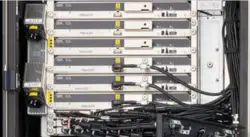
|
A configurable set of Bulk power regulators (BPRs). |
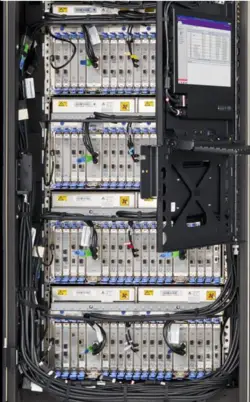
|
The entire bottom part of the rack consists of up to four PCIe I/O drawers, installed top-down. |
A Frame[edit]
System[edit]
The IBM z14 mainframe is the successor to z13, offering a large set of enhancements over the prior generation in all key areas such as scalability, security, and performance.
Drawer[edit]
The IBM z14 mainframe consists of a number of drawers. A drawer is simply a cluster of processors and chipsets. Each drawer consists of two clusters of three central processors (CPs) each and a single system controller (SC) chip. A full drawer can thus have a total of six processors and a single system controller. The X-bus interconnect links each CP chip to every other CP chip in the cluster and each CP chip to the SC chip.
The SC chip can links one drawer to another for up to four drawers in the max z14 mainframe system. In a max configuration, the z14 can have a total of 24 processors. With up to 10 cores per processor, in theory, a maximum-configured system can have a total of 240 cores. Note that some chips are reserved for redundancy, so a max drawer has 41 active cores for a maximum of 164 cores with four drawers. Drawers are linked together by linking each SC to every other SC in the other drawers over the A-bus. This is done through SMP connectors and cables. All four drawers are then fully connected to all other drawers.
Central Processor[edit]
Fabricated on a 14 nm process, the central processor is largely an evolutionary designed based on the previous z13 architecture featuring a very long out-of-order pipeline for high frequency design. Running at up to 5.2 GHz for a 0.192 ns cycle time, chips come with either 7, 8, 9, or 10 active cores enabled.
Die[edit]
Central Processor (CP) Chip[edit]
- GlobalFoundries 14HP Process
- CMOS FinFET SOI
- 17 Metal Layers
- deca-core (10 Processor Units (PUs))
- 5.2 GHz (192 ps cycle time)
- 6,100,000,000 transistors
- 14.4 miles of copper wire
- 26.5 x 27.8 mm † OR 25.3 mm x 27.5 mm‡ die
- 736.7 mm²† OR 695.75 mm²‡ die size
- 18,581 power pins
- 1,505 signal pins
(† - size provided by IBM in their presentations; ‡ - size provided by the IBM RedBook)
Core[edit]
Below is a layout of a single physical core:
- L2 - L2I$ + L2D$
- PC + TP - Core pervasive unit (instrumentation/error collection) + Trap
- LSU - Load-store unit (+ L1D$)
- XU - Translation unit (TLB + DAT)
- ICM - Instruction cache & merge
- COP - Dedicated Co-Processor
- FXU - Fixed-point unit
- VFU - Vector and Floating point Unit
- ISU - Instruction sequence unit
- RU - Recovery unit
- IDU - Instruction decode unit
- IFB - Instruction fetch and branch prediction
System Controller (SC) Chip[edit]
- GlobalFoundries 14HP Process
- CMOS FinFET SOI
- 17 Metal Layers
- 25.3 x 27.5 mm die
- 695.75 mm² die size
- 7,100,000,000 transistors
- + 2,100,000,000 cells of eDRAM (~2.1B xTors + 2.1B capacitors)
- 672 MiB shared eDRAM L4 Cache
| codename | z14 + |
| core count | 7 +, 8 +, 9 + and 10 + |
| designer | IBM + |
| first launched | July 17, 2017 + |
| full page name | ibm/microarchitectures/z14 + |
| instance of | microarchitecture + |
| instruction set architecture | z/Architecture + |
| manufacturer | GlobalFoundries + |
| microarchitecture type | CPU + |
| name | z14 + |
| process | 14 nm (0.014 μm, 1.4e-5 mm) + |
